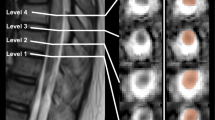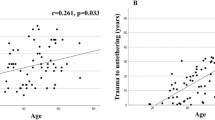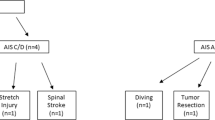Abstract
Introduction: The effect of spinal deformity with posttraumatic kyphosis and stenosis of the spinal canal in producing secondary changes of the spinal cord has been discussed for quite some time. Since the advent of magnetic resonance imaging (MRI), 20–40% of patients with posttraumatic paraplegia are found to develop hydromyelia. Purpose of our study: To evaluate the influence of residual spinal deformity, defined by the extent of the posttraumatic kyphosis and stenosis, in the development of posttraumatic hydromyelia. Material and methods: Two hundred and seven cases of traumatic paraplegia with MRI follow-up were reviewed retrospectively. A minimum of 3 years duration between trauma and MRI study was required (mean 10.6 years [3.2–38.3]). For statistical analysis two groups of patients were formed: with hydromyelia and without hydromyelia. After healing of the fracture, the extent of the kyphosis and stenosis, as well as the characteristics of the paraplegia were noted. Results: We found that 53 patients had hydromyelia. A highly significant correlation was found for the extent of spinal stenosis and the amount of kyphosis. Cluster analysis indicated that patients with more than 15 degrees of posttraumatic kyphosis and more than 25% of stenosis were twice as likely to develop hydromyelia. The level of the lesion and the remaining neurological function was not proven to have any influence towards the development of hydromyelia. Conclusions: These results support the idea that chronic mechanical stress to the spinal cord increases the risk for the development of hydromyelia. Surgical reconstruction should be considered for all patients to prevent secondary changes of the spinal cord.
Similar content being viewed by others
Log in or create a free account to read this content
Gain free access to this article, as well as selected content from this journal and more on nature.com
or
Author information
Authors and Affiliations
Rights and permissions
About this article
Cite this article
Abel, R., Gerner, H., Smit, C. et al. Residual deformity of the spinal canal in patients with traumatic paraplegia and secondary changes of the spinal cord. Spinal Cord 37, 14–19 (1999). https://doi.org/10.1038/sj.sc.3100740
Published:
Issue date:
DOI: https://doi.org/10.1038/sj.sc.3100740
Keywords
This article is cited by
-
Development of pre-syrinx state and syringomyelia following a minor injury: a case report
Journal of Medical Case Reports (2020)
-
Treatment of posttraumatic syringomyelia: evidence from a systematic review
Acta Neurochirurgica (2020)
-
Neglected traumatic spinal cord injuries: causes, consequences and outcomes in an Indian setting
Spinal Cord (2013)
-
Perilesional myeloradiculopathy with tethered cord in post-traumatic spinal cord injury
Spinal Cord (2013)
-
Factors associated with early onset post-traumatic syringomyelia
Spinal Cord (2012)



